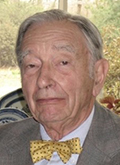Robert Forster, Physiology
 Robert Elder Forster II, M’43, an emeritus professor of physiology in the Perelman School of Medicine, passed away on September 19, 2021. He was 101.
Robert Elder Forster II, M’43, an emeritus professor of physiology in the Perelman School of Medicine, passed away on September 19, 2021. He was 101.
Dr. Forster was born in 1919 in the Philadelphia suburbs and graduated from Radnor High School. He received a BS from the Sheffield Scientific School at Yale University in 1941, then received an MD from Penn in 1943. He did a year-long internship at the Peter Bent Brigham Hospital in Boston, then spent two years as a captain in the U.S. Army Quartermaster Corps in the Climatic Research Laboratory in Lawrence, Massachusetts. Dr. Forster took a postdoctoral fellowship in the department of physiology at Harvard, then in 1951, Julius Comroe recruited him to join the department of physiology at Penn’s School of Medicine.
Immediately, Dr. Forster had an impact on Penn’s department of physiology and the field at large. In 1959, he became graduate chair of the department, and eleven years later he became the department chair, a position he held until retiring in 1990. In 1962, Dr. Forster received a generous grant from the U.S. Public Health Service to research the gas uptake of blood cells, research that led him to speak internationally. He had an impressive record of service around Penn, ranging from University Council and Faculty Senate committees to special committees for the selection of new deans, which drew upon his medical expertise. Dr. Forster continued probing and innovating long into his career, receiving a University Research Foundation (URF) grant as late as 1996; he had an active NIH grant supporting his research until 2005.
Dr. Forster’s research focused on CO2 and HCO3 exchanges and chemical reactions, using rapid mixing instruments and stable isotopes. He studied carbonic anhydrase in cells and subcellular particles, as well as pulmonary capillary gas exchange, blood flow, gas exchange, alveolar ventilation, carbon dioxide metabolism, and carbonic anhydrases. In 1956, Drs. Forster and Comroe wrote The Lung, a textbook that was later updated three times; Dr. Forster’s research was also published extensively in peer-reviewed publications. In 1973, he was inducted into the National Academy of Sciences; twenty years later, he also received a prestigious Von Humbolt Fellowship. Dr. Forster was a member of the Society of General Physiologists, the Biophysical Society, the American Physiological Society (where he served as president from 1966 to 1967), and the American Society for Clinical Investigation. Outside of academia, Dr. Forster was a member of an advisory committee to NASA that had recommended against using 100% oxygen during tests on the ground before the Apollo 1 fire in 1967.
In his free time, Dr. Forster loved to sail his ketch, the Tyche, and his sloop, the Old Cove. He also enjoyed playing tennis at the Merion Cricket Club and the Duxbury Yacht Club.
He is survived by his four children, Julia Bacon Forster, Jameson Forster, John Montgomery Forster V, and Elizabeth (Babs) Forster Camerota; nine grandchildren; and three great-grandchildren.
Dr. Forster’s life will be celebrated at the Church of the Redeemer in Bryn Mawr on Saturday, November 13 at 11 a.m. The service will be livestreamed on www.theredeemer.org. He will be interred next to his late wife, Elizabeth Hilbert Day, in Duxbury, Massachusetts. In lieu of flowers, gifts can be made to Penn Medicine’s department of physiology. Checks can be made out to “The Trustees of the University of PA – Physiology.” In the memo section, add “In Honor of Dr. Robert E. Forster II” and mail to: c/o Andrew Bellet, 3535 Market Street, Suite 750, Philadelphia, PA 19104.
